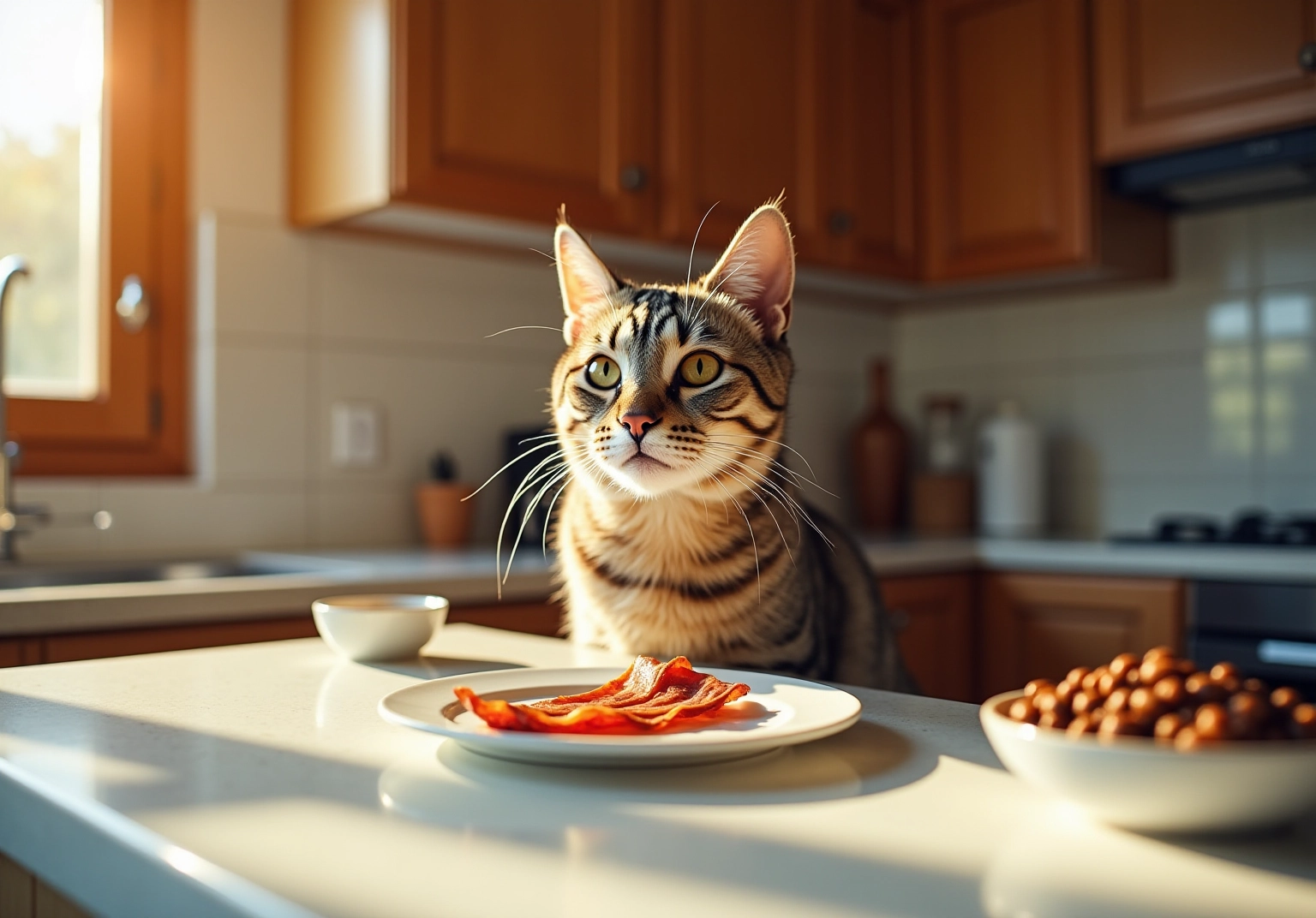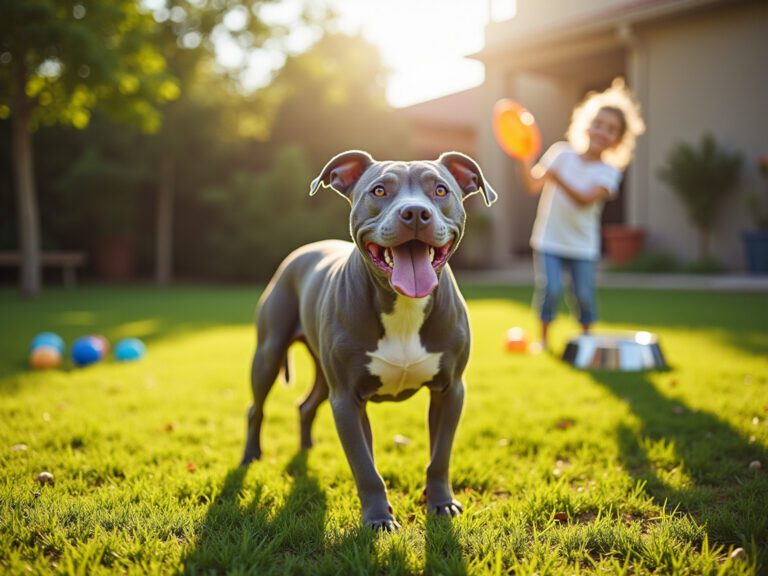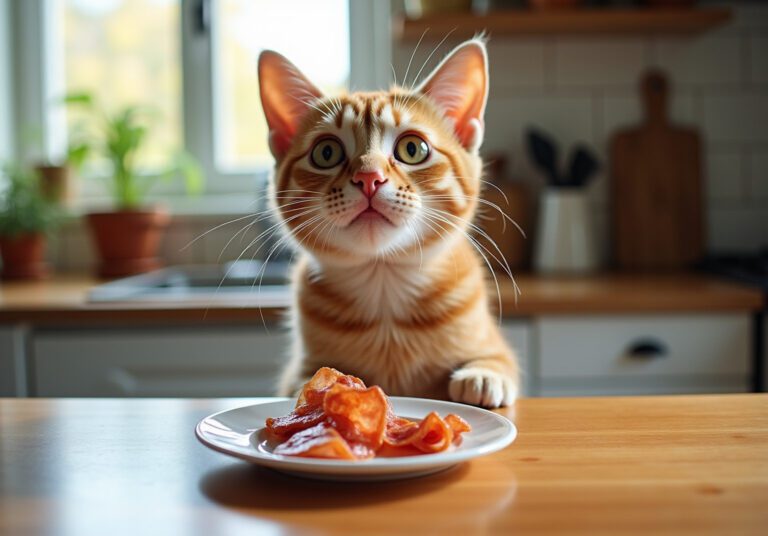Can Cats Eat Bacon? Understanding Risks and Safe Practices
Overview
As loving pet owners, it’s natural to wonder about the foods we share with our furry family members. While cats can enjoy bacon in moderation, it’s essential to be aware of the health risks associated with its high sodium and fat content. These factors can lead to obesity and other medical issues that concern us all. At Adventure Den, we understand the importance of meeting our feline friends’ dietary needs.
To keep your beloved pets healthy, we suggest safe practices, such as:
- Limiting both the portions of treats like bacon
- Limiting the frequency of treats like bacon
This approach not only mitigates the risks but also ensures that your cats receive the proper nutrition they deserve. Remember, your cat’s well-being is our priority, and together, we can create a nurturing environment for them to thrive. Let’s make informed choices that keep our pets happy and healthy!
Introduction
Understanding the dietary needs of your furry family members is crucial for any pet owner, especially when it comes to tempting human foods like bacon. The savory aroma and rich fat content of bacon can make it an irresistible treat, but it raises important questions about its nutritional value and potential health risks.
Can your beloved cat safely indulge in bacon, or does the allure of this cured meat come with hidden dangers that could affect their well-being? This article delves into the complexities of feeding bacon to cats, exploring the delicate balance between enjoyment and health, ensuring that you can make informed choices for your cherished companions.
Explore Feline Nutritional Requirements
Cats are obligate carnivores, meaning their nutrition must primarily consist of meat to thrive. Understanding these dietary needs is essential for pet owners, as it highlights the importance of providing the right nutrients for your furry family members.
- Protein: Cats require a high protein intake, typically around 26-30% of their diet, to support muscle development and overall health. According to AAFCO guidelines, adult cats need a minimum of 26% protein in their nutrition. Research suggests that meal plans containing under 40% protein may lead to a reduction of lean body mass over time, underscoring the significance of sufficient protein levels for their well-being.
- Taurine: This essential amino acid, predominantly found in animal tissues, is vital for the health of the heart and eyes. Cats need nine vital amino acids from their food, including taurine and arginine, since they cannot produce enough taurine independently. Ensuring your cat gets enough taurine is crucial for their overall health.
- Fat: Beneficial fats are essential for energy and skin wellness, but should not exceed 20% of their diet to avoid obesity and related issues. Maintaining a balanced fat intake is key to keeping your cat healthy.
- Vitamins and Minerals: Cats require specific vitamins, such as A, D, and B vitamins, along with minerals like calcium and phosphorus, which are typically found in animal products. These nutrients play critical roles in various bodily functions, including vision, bone health, and metabolic processes.
By comprehending these dietary needs, pet owners can ensure they are meeting the nutritional requirements of their cats. It’s important to remember that not all human foods, such as pork, satisfy a cat’s nutritional needs, which raises the question: can cats eat bacon? At Adventure Den, we understand your concerns and are here to support you in creating a nurturing environment for your beloved pets.
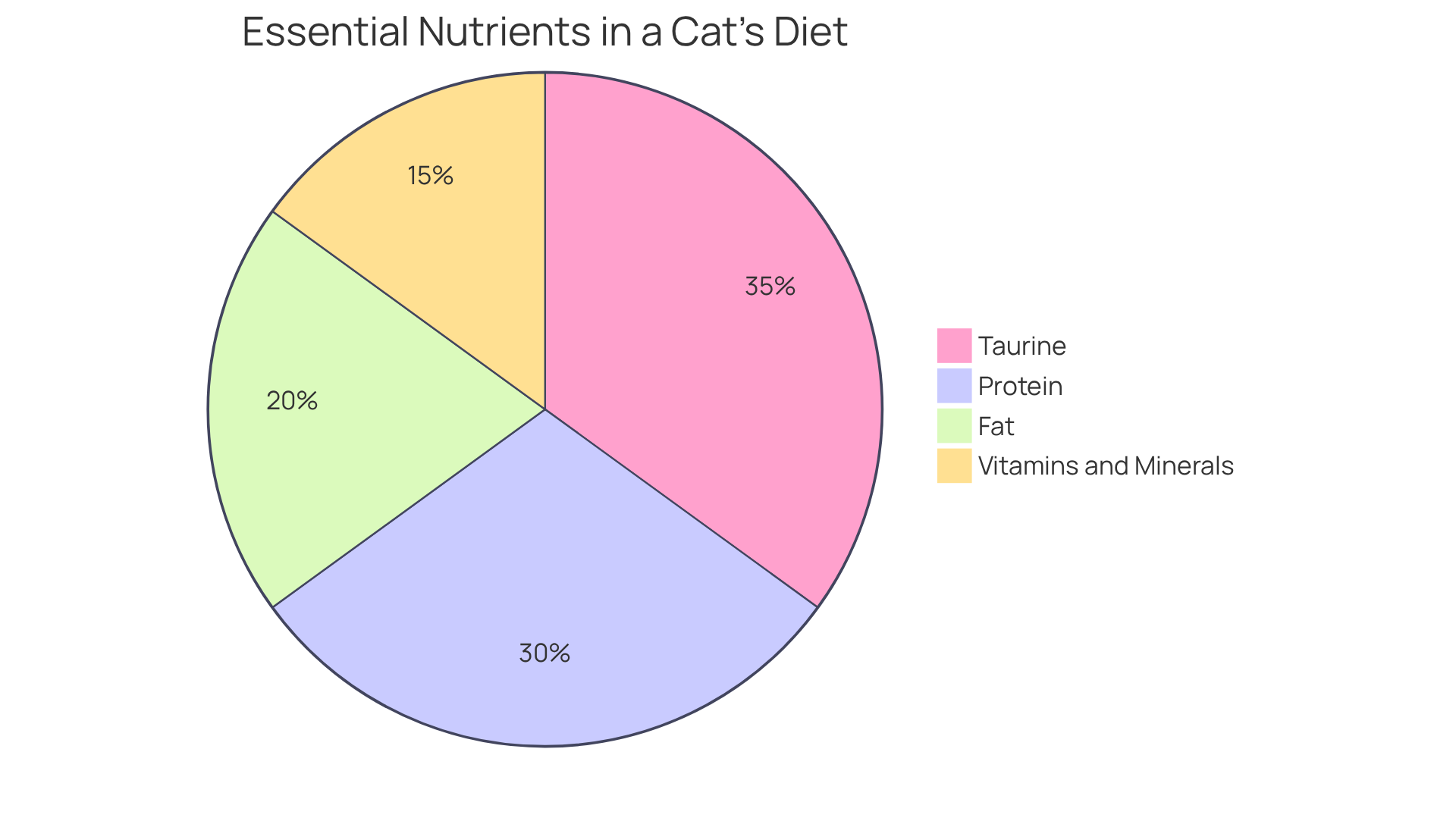
Understand the Allure of Bacon for Cats
Bacon’s allure for your furry family members can be attributed to several key factors that every caring pet owner should understand:
- Umami Flavor: Cats have a heightened sensitivity to umami, the savory taste that bacon offers. Research shows that felines have evolved a wider perception of umami flavor compared to humans, making pork particularly appealing as it aligns with their natural inclination for protein-dense meals.
- Fat Content: The high-fat content in this cured meat is another significant draw. As obligate carnivores, cats instinctively seek energy-rich foods, and the richness of pork satisfies this instinct beautifully.
- Scent: With up to 200 million odor receptors, cats possess an exceptional sense of smell. The scent of frying meat is incredibly strong, often prompting them to beg for a taste.
However, it’s crucial to recognize that this meat does not fulfill a cat’s nutritional requirements. Regular consumption can lead to health issues, so moderation is key. Moreover, felines lack sweet taste receptors, rendering sugary foods unappealing to them. This further clarifies why savory and fatty choices, such as pork, are more enticing. Additionally, research indicates that cats favor foods with elevated levels of free amino acids, enhancing the savory and fatty tastes and making cured pork even more attractive.
As a loving pet owner, understanding these factors will help you provide a nurturing environment for your beloved companions while keeping their health in mind.
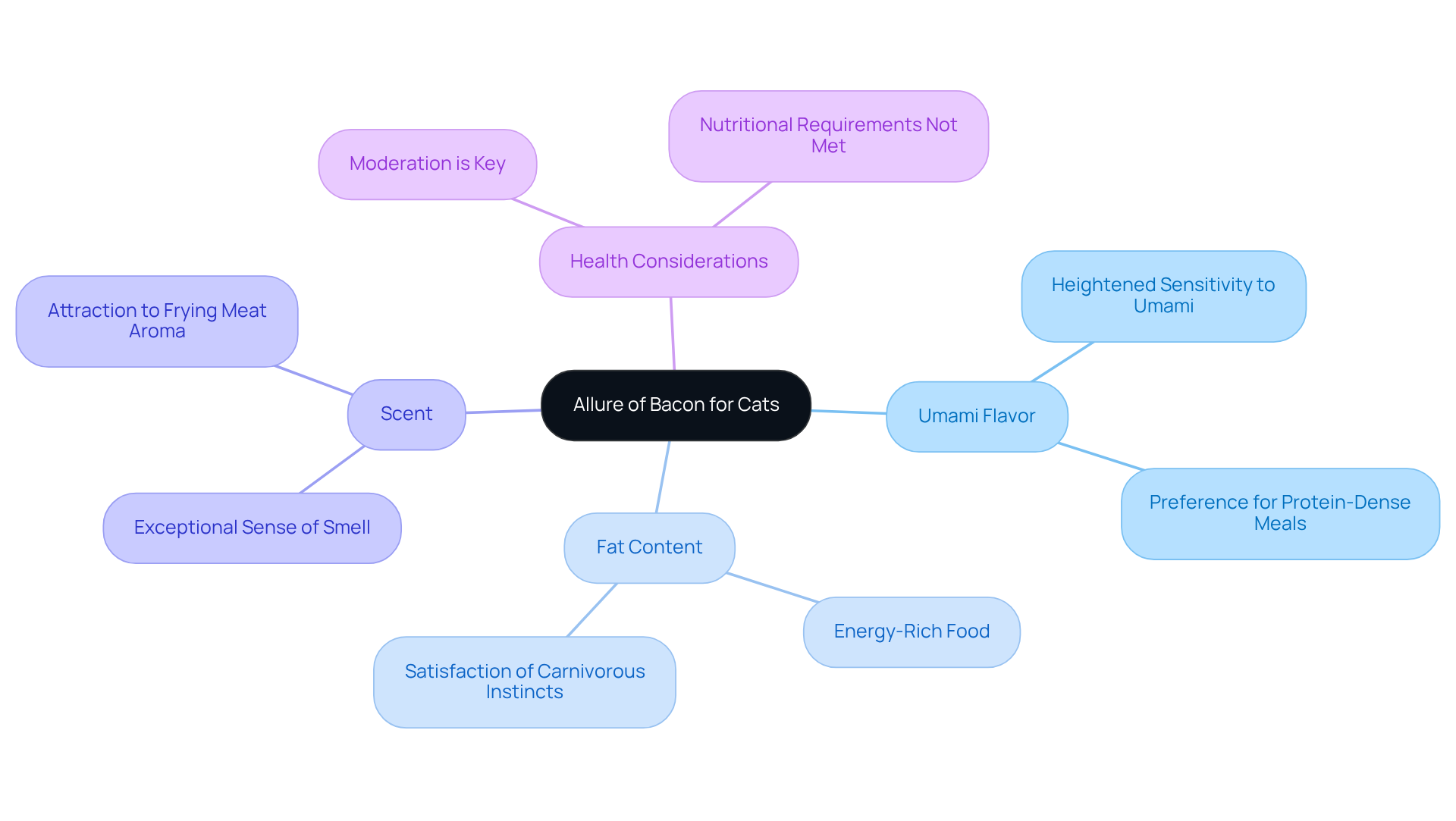
Evaluate Health Risks and Benefits of Bacon in Cat Diets
While bacon may not be toxic to your furry family members, it does come with several significant health risks that you should consider as a caring pet owner:
- High Sodium Content: Bacon is notoriously high in salt, which can lead to dehydration, increased thirst, and in severe cases, sodium ion poisoning. It’s important to note that excessive sodium consumption can negatively impact kidney function and blood pressure in cats. Keeping an eye on their dietary sodium levels is essential for their health.
- Fat and Calories: The high-fat content in bacon can contribute to obesity, a growing concern among our beloved felines. Studies show that obesity levels in cats are associated with high-fat eating habits, leading to serious medical issues like diabetes and pancreatitis. Cats that indulge in high-fat foods face a greater risk of developing metabolic disorders, including insulin resistance.
- Lack of Nutritional Value: Unfortunately, bacon lacks the essential nutrients that cats need for optimal well-being, making it a poor dietary choice. Instead of providing beneficial nutrients, it may replace healthier food options in your cat’s meals, which can be detrimental in the long run.
In moderation, a small portion of cured meat may not result in immediate harm, but frequent intake can lead to significant health concerns. This highlights the importance of a balanced meal plan tailored to your cat’s nutritional needs, ensuring they thrive in a nurturing environment.
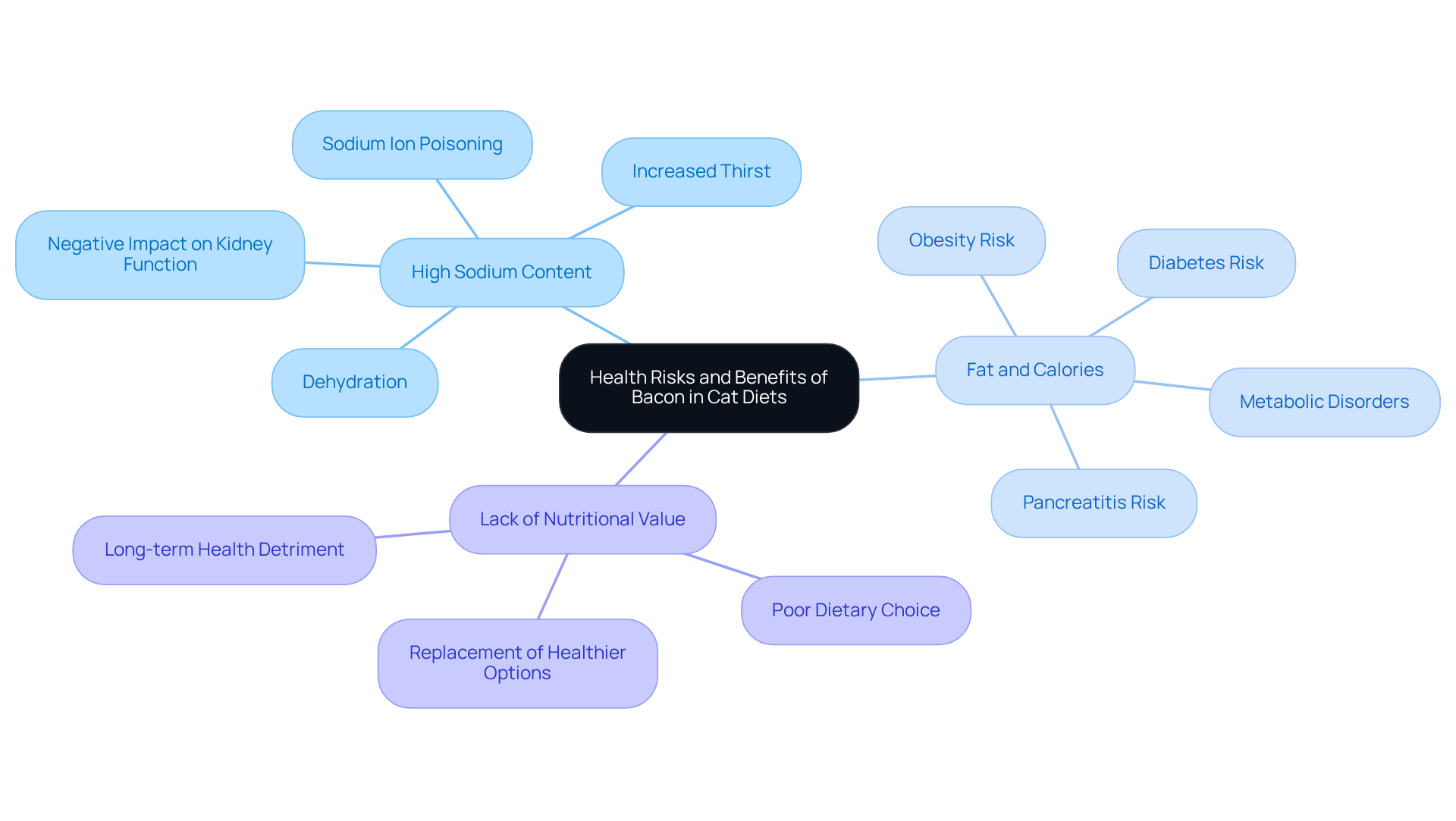
Implement Safe Practices for Feeding Bacon to Cats
When considering giving your furry family member bacon, it’s essential to follow these safe practices to ensure their well-being:
- Limit Portions: Offer only a small piece, roughly the size of your fingernail, ensuring it is cooked and devoid of fat. This small gesture can keep your cat happy and healthy.
- Frequency: Treat this food as an occasional delight rather than a staple in their meals; once a month is a sensible guideline to maintain balance.
- Monitor Reactions: After giving your cat some pork, keep a watchful eye for any signs of gastrointestinal distress, such as vomiting or diarrhea. Your attentiveness can make all the difference.
- Consult Your Vet: Always seek advice from your veterinarian before introducing new foods to your cat’s diet, especially if your feline friend has existing medical issues.
Veterinarians recommend that treats, including meat products, should make up only 4-10% of a cat’s daily diet. By following these guidelines, you can safely care for your beloved pet while reducing potential safety risks. It’s worth noting that 58% of dog owners and 12% of cat owners give treats more than once a day, which can contribute to obesity; thus, moderation is key. Treats should not exceed 10 to 15 percent of a cat’s daily caloric intake, aligning with veterinary recommendations for maintaining a healthy weight. Remember, when considering if cats can eat bacon, it’s important to note that excessive bacon consumption can lead to health issues in cats, including obesity, salt poisoning, and feline hypertension. Let’s work together to create a nurturing environment for your cherished companion.
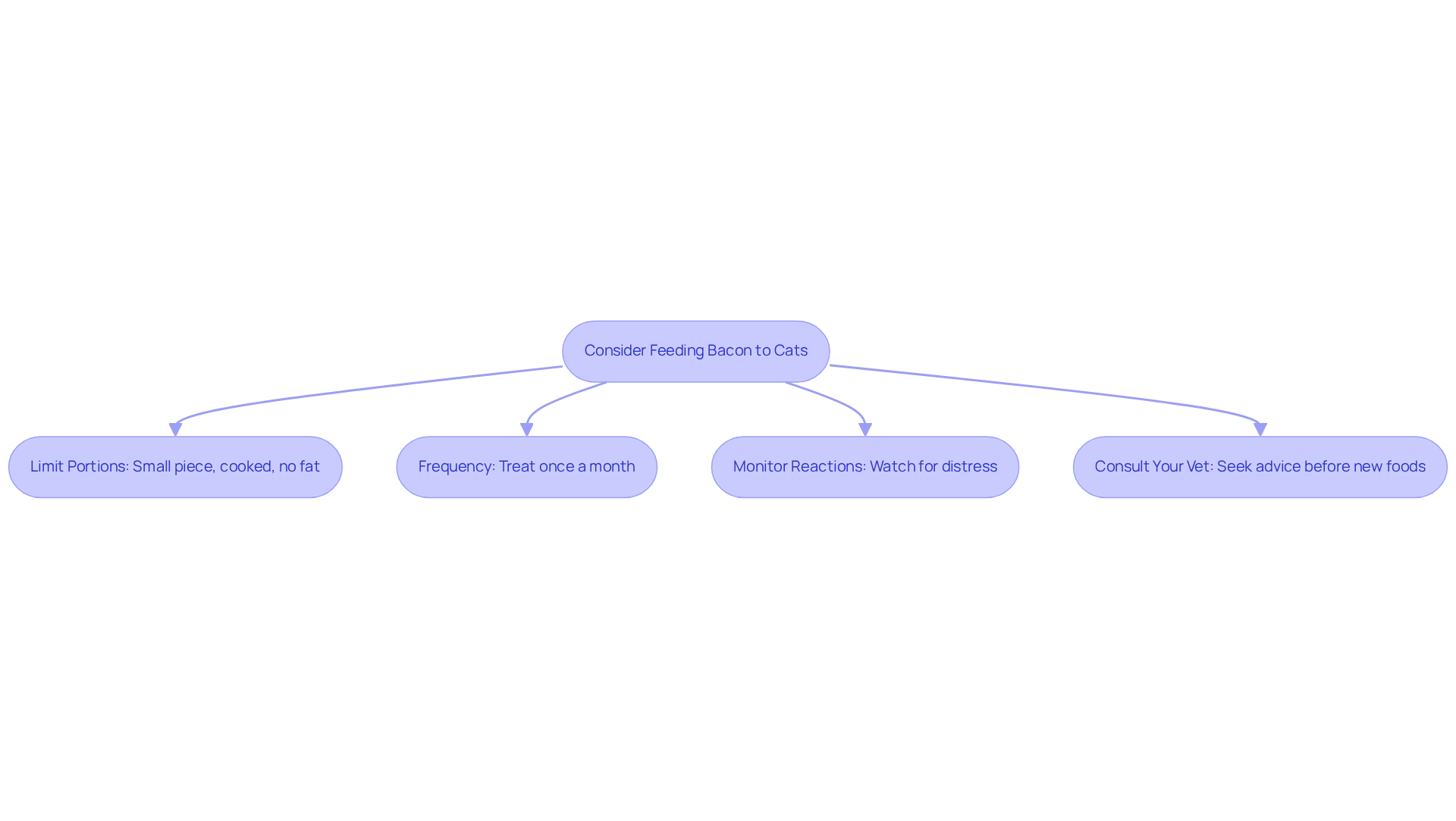
Conclusion
Understanding the complexities of feline nutrition is crucial for every cat owner, especially when considering human foods like bacon. While bacon may seem like an enticing treat due to its savory flavor and appealing scent, it is essential to recognize that it does not meet the nutritional needs of cats. The risks associated with feeding bacon, including high sodium content, excessive fat, and lack of essential nutrients, can lead to serious health issues over time.
Throughout this discussion, we’ve highlighted key points regarding the dietary requirements of cats, the allure of bacon, and the potential health risks involved. Cats thrive on a diet rich in protein, taurine, and balanced fats, making it imperative to prioritize their nutritional needs over indulgent treats. Moreover, our conversation on safe practices emphasizes the importance of moderation and vigilance in monitoring your cat’s health when introducing any new food into their diet.
Ultimately, the well-being of your furry family members should always come first. By understanding the implications of feeding bacon and adhering to safe practices, you can create a nurturing environment that promotes the health and happiness of your beloved cats. It is always best to consult with a veterinarian for tailored dietary advice and to explore healthier treat alternatives that align with a cat’s nutritional requirements. Prioritizing your cat’s health will ensure they live a long, vibrant life filled with joy.
Frequently Asked Questions
What are the primary dietary needs of cats?
Cats are obligate carnivores, meaning their nutrition must primarily consist of meat to thrive. Understanding these dietary needs is essential for providing the right nutrients for their health.
How much protein do cats require in their diet?
Cats require a high protein intake, typically around 26-30% of their diet. According to AAFCO guidelines, adult cats need a minimum of 26% protein to support muscle development and overall health.
Why is taurine important for cats?
Taurine is an essential amino acid vital for the health of the heart and eyes. Cats need taurine and other vital amino acids from their food because they cannot produce enough taurine independently.
What role do fats play in a cat’s diet?
Beneficial fats are essential for energy and skin wellness in cats but should not exceed 20% of their diet to avoid obesity and related health issues.
What vitamins and minerals do cats need?
Cats require specific vitamins, such as A, D, and B vitamins, along with minerals like calcium and phosphorus, which are typically found in animal products. These nutrients are crucial for various bodily functions, including vision, bone health, and metabolic processes.
Can all human foods satisfy a cat’s nutritional needs?
No, not all human foods satisfy a cat’s nutritional needs. For example, some foods like pork may not meet their dietary requirements. It’s important to provide a balanced diet specifically tailored for cats.

